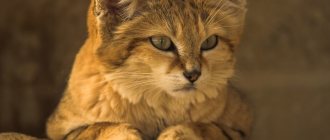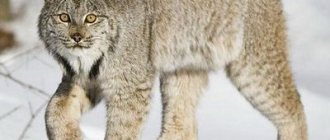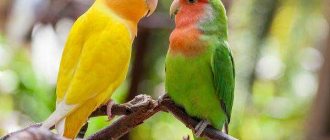Manul is a representative of the wild cat world, which, according to global network ratings, is one of the most popular exotic animals. Unusual long hair, small ears pressed to the head, and the intelligent look of amazing eyes made this cat a real Internet star.
Do not forget that this is not a breed of cute pet, it is a wild predator that is unlikely to ever be able to get along with a person.
Description and origin of the species
The first scientific description of the animal was given by the German naturalist Peter Simon Pallas in 1776. He met the animal while traveling in eastern Siberia, and gave the cat its first scientific name Felis manul.
In 1842, Johann-Friedrich von Brandt, a German naturalist working in Russia, proposed placing the animal in a separate genus of Pallas' cat (
Otocolobus
).
Later in 1907, the British zoologist Reginald Innes Poukok finally approved the classification: the animal is the only representative of the monotypic genus of Pallas's cats, and bears the scientific name Otocolobus manul.
The name manul is borrowed from the Kyrgyz language, and translated means “cat” in Kyrgyz. In Mongolian the word sounds a little different, “manol”. The name Pallas' cat was first proposed by the English zoologist William Blanford. Latin genus name Otocolobus
comes from ancient Greek, and literally means dwarf ear.
The closest relative of the animal is the genus Eastern cats (Prionailurus). It includes small predators of the cat family that live exclusively in Asia - the Bengal cat, the Sumatran cat, the fishing cat and the spotted cat. According to mitochondrial DNA analysis, the ancestors of Pallas's cat separated from a common ancestor with eastern cats from 9.4 to 1.46 million years ago.
Origin of the Pallas cat breed
50 million years ago, on our small planet there lived a miacid beast, which is the ancestor of all dogs, cats, bears and other terrestrial mammals. Approximately 30 million years ago, from this miacide, Diniktus appeared - the ancestor of the ancestors of all cats on Earth. He was the size of a large lynx, had unusually thick fur, an elongated body, like a weasel, a short tail and enviable mobility, sense of smell, strength and speed of reaction at that time. A little less than 10 million years ago, Dinikt began to “branch” into large and small cats, having first shortened the spine and elongated its paws. And about 1 million years ago, all cats acquired the appearance that is familiar to our eyes.
But the Pallas's cat has not become a single species of cat; it itself is a transitional form, practically a living relic.
How do big cats differ from small cats? Is it just the size? Of course not! Big cats can roar! They emit a deep, strong and loud roar, notifying everyone of their presence - once. For example, a puma, a kitty, is not at all tiny, but it does not know how to roar, which is why it is classified as a small cat.
In all big cats the pupil narrows into a point, and in small cats it narrows into a slit, so in photographs of lions or jaguars they often have such a “human” facial expression - that’s two.
Now let's take a closer look at the manul. A dense small body with short legs, a round typical cat head, widely spaced bright yellow eyes with ... a round pupil. So, it should be classified as a big cat, despite its small size?
But he doesn’t know how to roar at all!
He does not know how not only to roar, but even to meow or purr, which even ocelots tamed in captivity or tigers that have become tame learn to do.
By the way, tame means that they are tamed to the hands of a person, but this does not mean that they live in his home. Handmade and homemade are different concepts!
Wild small cats, for example, the Norwegian Forest or European Forest, never become completely domestic, even after getting used to the hands of a person and responding to his caresses with a hoarse purr, they still retain a large amount of independence.
Manul will not give up his independence one iota and never!
Throughout its 10-12 years of life, this cat, having lived side by side with a person, will never learn to trust the caring hands of its owner, because... he simply does not have a tameness reflex, because this breed of wild cats developed and remained in its original form almost 10 million years ago. At that time, no one had tamed anyone, and man himself, as a species, was absent on planet Earth.
What does a manul look like - size and appearance
Pallas's cat is comparable in size to domestic cats. The body length of the animal is from 46 to 65 cm, the tail length is from 21 to 31 cm. The weight of the cat is on average from 2.5 to 4.5 kg. The animal has a stocky build, short legs and thick long fur, so in appearance the cat seems denser and more massive than it actually is. Pallas's cat has the thickest fur of all cats - there are up to 9,000 hairs per square centimeter, each up to 9 cm long.
The color of the animal varies from light gray to dark yellow, with vertical dark stripes on the body and front legs. In winter, the fur is grayer, and with less pronounced stripes, than in summer. at the ends the hair is painted white, which gives the skin a snow-dusted appearance. Dark rings are clearly visible on the tail, and dark spots on the forehead. On the cheeks, horizontal dark stripes extend from the corners of the eyes to the side. Dark and white circles around the eyes emphasize their round shape. There is light fur on the chin and throat, which smoothly blends into light gray on the belly.
Pallas' cat's paws are proportionally the shortest among all cats. The ears are very small, and low set and fairly wide apart. The muzzle is noticeably shorter than that of other cats, so it seems that the animal is looking from under its brows. Due to its short jaw, the cat has fewer teeth than other wild cats, but has long fangs. The animal has short claws, and unusual round pupils, compared to other felines.
Adaptive abilities
Unlike domestic cats, the Pallas cat needs to be constantly on the alert. His greatest enemy is the wolf. In addition to the direct threat, life itself in the steppe requires special skill:
- The Palace cat's eyelids are equipped with nictitating membranes that protect it from strong and dry winds;
- This cat is very flexible and evasive, which can squeeze into the narrowest passages;
- Sharp vision and good hearing allow him not only to hide from danger in time, but also to find food himself;
- Pallas' cats have a rapid reaction to any irritant, which also helps him when threatened. Quite often, these cats make frightening sharp sounds and even attack the enemy.
Character and lifestyle
Manul, like other wild cats, leads a solitary and sedentary lifestyle. Each animal has its own territory, which they mark with scent marks. The size of its own range varies depending on the habitat and food supply, but no more than 10 square kilometers per predator.
During the day, animals rest in caves, rocky outcrops, former dens of marmots and foxes, and at dawn and in the late afternoon they go hunting. Cats hunt prey from ambush, or sneak up unnoticed, using stones and bushes for cover. The color of the animal perfectly camouflages it among the snow and stones.
Pallas cats are the most clumsy and slow of all wild cats. They are not adapted to running, and chase prey, relying solely on surprise attacks from ambush. In case of danger, they hide, camouflage themselves against the background of stones, and climb onto the rocks.
Peculiarities of Pallas's behavior
Pallas's cat leads a solitary lifestyle and is not prone to moving long distances. Manul makes shelters in rocks, caves, narrow holes, and also occupies burrows left by other animals - badgers, marmots, foxes. This predator behaves very slowly in everyday life, even seeming clumsy and clumsy.
During the day he usually sleeps in the den, and at dusk he goes out hunting. Color helps the animal blend in with its environment and be invisible. Both when hunting and when defending, Manul prefers to hide and wait; he cannot run fast and does not like rapid movements.
It can quite deftly climb rocks and climb into a narrow crevice, where a large predator definitely cannot reach. But Manul practically does not know how to climb trees.
If a cat is alarmed, it emits a characteristic snort or a hoarse rumbling sound.
Such a high level of caution in Pallas's cat is explained by a large number of natural enemies - wolves, wild and feral dogs, eagles, eagle owls, and bears.
The Manul can watch its future prey from ambush for hours, often tracking it at a hole, but the attack on the victim can be swift and unmistakable.
Manul seems gloomy and unfriendly. Indeed, this animal does not really favor even its relatives.
Pallas's cat is perfectly adapted to life in the steppe. The animal is not afraid of dry, frosty wind. The body is protected by long hair with a thick undercoat, and the eyes have special membranes that, due to frequent blinking, protect the cornea from dehydration.
Despite his slowness, the Manul is able to cover a short distance very quickly, but then needs a long sleep. This is due to the small size of the heart sac, due to which the vascular system cannot withstand long-term loads.
The animal's hearing, vision and sense of smell are excellent, so the steppe is its home. He is able to sense danger from afar and hide, crawl into the narrowest crevice, and if necessary, he can defend himself, growling menacingly and showing sharp fangs.
Where does the manul live?
Pallas's cat lives in the steppes of Central Asia. It can be found in the following countries:
- Kazakhstan
- Tajikistan
- Kyrgyzstan
- Iran
- Afghanistan
- Pakistan
- Nepal
- India
- Butane
- Mongolia
- China
- Russia
In Russia, the Pallas's cat lives in the Trans-Baikal Territory, Chita, Altai, the Republic of Tyva and Buryatia. The animal is found in western China. Previously, Pallas's cat also lived in Armenia and Azerbaijan (in 2017 it was seen in the Zangezur National Park of Azerbaijan), but according to data for 2022, the populations in these countries have been almost completely exterminated.
As a habitat, the Pallas's cat prefers open steppe spaces with low snow cover in winter and a sharply continental climate. It is found in the highlands at an altitude of up to 4,000 meters above sea level - in rocky crevices, rocky outcrops, semi-desert areas of mountains and bush thickets. Practically does not live in forests and lowlands.
Habitat
A comfortable habitat for Pallas’ cats is the key to a long and well-fed life. The wild cat lives in nature in Central and Central Asia, and is found in Europe and even in Russia.
Often a name is assigned to a cat based on its place of residence. Thus, in Altai, in Tuva and in the Krasnoyarsk Territory, the Transbaikal Pallas's cat lives (all these areas are located just beyond Lake Baikal, they are called Transbaikalia).
Its Trans-Caspian brother is most common in more eastern latitudes: it is comfortably located in Uzbekistan, Pakistan, Iran and Kyrgyzstan. Tibetan Pallas' cats live in the steppes and mountain crevices of Nepal and, of course, Tibet.
The life and diet of a wild cat take place in steppe and semi-desert areas, covered with low grass and thickets of low bushes. The predator can handle small obstacles, but you won’t find it near steep cliffs.
Types of Pallas's cats
Within the species, there are three breeds for Pallas cats. They are not very different from each other, there is only a minor difference in color.
- The common or Siberian Pallas cat has a standard light gray color and lives in Siberia, Mongolia and China. It was this subspecies that was discovered by the naturalist Pallas;
- Central Asian Pallas's cat - this species is distinguished by its reddish-brown color and clearly visible reddish-brown stripes on its body. This subspecies has been known since 1842. The main habitats are Uzbekistan, Iran, Turkmenistan and Afghanistan.
- Tibetan Pallas's cat - its fur is darker than that of the usual representative of the breed, and in winter it acquires a precious silver tint. The forest cat lives in Tibet, Nepal, India and Pakistan. He became known to the world at the same time as his Central Asian brother.
What does manul eat?
Pallas's cat feeds mainly on pikas, small birds (Asian mountain partridge), and mice (clawed gerbil, vole). The pika is a small animal belonging to the lagomorphs, the size of a hamster. Less commonly, Pallas's cat hunts tolai hares, gophers and young marmots. In the summer, when there are few pikas, the cat actively eats insects - grasshoppers, locusts, etc.
Common subspecies of Pallas's cat
— Advertising —
Taking into account the geographical variability of the color and size of the animal, three subspecies are known for it:
- Otocolobus manul manul - distributed throughout its entire range, especially in Mongolia and western China. The coloring is typical.
- Otocolobus manul ferruginea - lives in countries such as Iran, Kazakhstan, Kyrgyzstan, Turkmenistan, Uzbekistan, Tajikistan, Afghanistan, Pakistan. The color of the fur is reddish-ocher, with clearly visible reddish stripes.
- Otocolobus manul nigripecta - distributed in Kashmir, Nepal and Tibet. The coat of this subspecies is grayish in color, becoming distinctly silver-gray in winter.
Reproduction and young
The mating season for Pallas cats is very short due to the harsh climate in its habitat. Estrus lasts only 26 to 42 hours, which is much shorter than that of other wild cats. Pregnancy lasts from 66 to 75 days, the female usually gives birth in April or May. In a litter, from 2 to 6 kittens are born. Kitten survival rate is quite low (44% of kittens die before 30 days of age), so large litters compensate for high mortality and harsh climate conditions.
Females give birth in a den lined with dry grass, feathers and wool. Crevices, small caves, and old holes of marmots, badgers, and foxes are used as dens. Kittens are born weighing only about 90 grams, blind and helpless, covered with thick fluffy fur, which is replaced by full adult fur at the age of 2 months. From 4 months, the cubs begin to hunt, at 6 months they reach the size of an adult cat and begin an independent life. Puberty in Pallas' cats occurs after 10 months.
Manul at home: possible problems
Domestic cats shed seasonally: in spring and autumn. During these periods, the Pallas's cat also renews its coat. The rest of the time, his long (up to 7 cm) coat and thick undercoat come out in clumps. To avoid “hair growth” on the furniture, carpets will have to comb the pet daily, who will avoid the procedure in every possible way and offer active resistance.
Be sure to read:
A cat that looks like a lynx: the best domestic and exotic breeds, features of their maintenance
The manul is similar in behavior to a grown-up puppy; he actively chews everything he finds attractive, gnawing shoes, table legs, sofas to splinters and small pieces.
Do not mind sharpening its claws on upholstered furniture, walls, laminate flooring, doors, leaving deep furrows. The strength of the manula's jaws and paws is superior to its domesticated relatives, and the damage will be much greater. It is useless to punish and educate a palassa cat.
Natural enemies and threats
Pallas's cat is often hunted by wolves and eagle owls. In addition, at a young age the animal is very susceptible to infectious diseases. A serious threat to the animal is snowy winters and prolonged ice, as well as a reduction in food supply - a decrease in the population of rodents, pikas and other prey.
Human actions currently pose a significant threat to the species:
- poachers kill animals for their skins in Mongolia, China and Russia;
- wild cats regularly fall into snares set for marmots and hares, and traps for wolves and foxes;
- animals are often killed by herding and domestic dogs.
Breed nutrition
If everything is fine with the kittens, then they grow quickly and by 3-4 months they already begin to hunt on their own. They hunt in the zoo, of course, on mice and lemmings thrown into their cages by zookeepers, but they also like lean beef.
The concentrated food from bags and cans familiar to our cats is strictly prohibited! And this is also another problem when raising young Pallas’ cats.
And, of course, the problem is their behavior! Pallas' cat kittens, by the age of hunting, grow very long, awl-shaped teeth, which with age will be replaced, of course, by wider and not so long permanent teeth, but the character inherent in nature is preserved from the first days.
These babies bite very painfully, inflicting painful wounds on the hand that feeds them, as soon as the attendant “gazes” a little while feeding or tries to stroke the pussy.
Population and conservation of the species
It is difficult to calculate the exact number of animals due to the inaccessibility of their habitat and excellent camouflage, but the number of cats is declining everywhere. According to data at the beginning of the 2000s, there were from 3,000 to 3,650 Far Eastern individuals left in Russia, most of them were in the Chita region.
The wild cat is listed as a “species of least concern” by the IUCN Red List and is included in the Russian Red Book. Hunting for Pallas's cat is prohibited in all countries of its habitat except Mongolia.
Since 2013, the Far Eastern Pallas's cat has been studied in the Daursky National Nature Reserve as part of the Russian Geographical Society's program for the conservation of Pallas's cat in Transbaikalia. The main goals of the program are to study the animal's natural habitats and migrations, as well as measure the survival rates of kittens and adults.
As of 2010, there were 47 individuals kept in zoos around the world. Pallas' cat breeds well in captivity, but they are highly susceptible to disease due to an underdeveloped immune system. In the wild, animals' habitat is limited, and outside of it, animals suffer from viruses that are not found in their natural environment of the highlands and steppes.
Eating habits. Hunting
The survival rate of Pallas cats depends on weight gain. Experts call this “fattening.” It's all about the harsh winters in the steppes in which they live. Pallas' cats never hibernate - they hunt all year round. So, the only way for them to survive is to store enough fat. In winter, the Pallas's cat can weigh up to 6-7 kg and constantly walks in search of food.
Due to their increased fluffiness, Pallas' cats are quite slow and clumsy, and they also have short paws, which also tend to sink in the snow. However, they make excellent hunters. Their camouflage allows them to blend into the surrounding landscape and kill their prey in one fell swoop.
Throughout its habitat, the Pallas' cat hunts mainly pikas and small rodents. He is able to track and ambush these animals in the rocky steppes where he lives. It is known to occasionally eat small birds and insectivores.
Manulas at home
Many people, seeing the unusual appearance of the animal, want to keep it at home. Yes, in size and appearance it really resembles a domestic cat, but the Pallas's cat is a wild animal, and will remain so even if you adopt a kitten. It will not be possible to tame it even after keeping it at home for a long time.
Keeping a Pallas's cat at home, in addition to its wild nature, will be associated with other difficulties:
- animals do not eat unfamiliar food
- animals often get sick and are susceptible to viruses, since their immune systems are adapted only to their limited habitat
- The animal's long and thick fur will not allow it to be kept at home; it will be too hot.
Captivity
Exotic appearance and small size, commensurate with the height and length of a pet, often mislead people. It is almost impossible to make a family pet out of a Pallas cat, even if you manage to buy a small kitten.
To all the difficulties of socialization are added health problems. As practice shows, in captivity up to 90% of Pallas' cats become infected with toxoplasmosis. Read about this disease in cats and people. In the steppe with bright sun and cold air, cats do not get sick, but at the slightest deviation from natural conditions, microorganisms are activated, and the infection seizes the animal.
Even in the conditions of a zoo, where the best veterinary specialists monitor the Pallas’ cat, and the living conditions are as close as possible to natural ones, not all animals are able to be released. This is another factor for refusing to keep Pallas's cat in a private house or apartment.
There are other reasons why you should not try to turn Pallas's cat into a pet.
This animal has a wild, quarrelsome disposition. Even small kittens, taken from their mother early, become uncontrollable during puberty.
At three or four months, little Pallas's cats awaken all the makings of a hunter, then not only furniture and walls, but also people can suffer from sharp claws and teeth. Although an adult animal reacts to people quite calmly, it does not show any signs of sympathy. Moreover, the cat will always try to hide and avoid any contact with the owner and household members.
Long, harsh hair will also cause a lot of trouble. Under constant stress, the animal will shed year-round, leaving clumps of hair everywhere.
Read about why cats shed and what to do about it.











